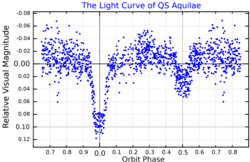QS Aquilae
Appearance
| Observation data Epoch J2000 Equinox J2000 | |
|---|---|
| Constellation | Aquila |
| Right ascension | 19h 41m 05.528s[2] |
| Declination | +13° 48′ 56.45″[2] |
| Apparent magnitude (V) | 5.988 |
| Characteristics | |
| Spectral type | B5V |
| U−B color index | −0.52 |
| B−V color index | −0.08 |
| Variable type | Eclipsing binary[3] |
| Astrometry | |
| Radial velocity (Rv) | −14.2 ± 2 km/s |
| Proper motion (μ) | RA: −0.04 ± 0.60[2] mas/yr Dec.: −11.47 ± 0.43[2] mas/yr |
| Parallax (π) | 0.49 ± 0.62 mas[2] |
| Orbit[3] | |
| Primary | QS Aquilae AB (eclipsing pair) |
| Companion | QS Aquilae C |
| Period (P) | 77.0±4.3 yr |
| Semi-major axis (a) | 0.111±0.045″ |
| Eccentricity (e) | 0.947±0.038 |
| Inclination (i) | 61.2±3.6° |
| Longitude of the node (Ω) | 144.5±5.1° |
| Periastron epoch (T) | 1962.3±2.3 |
| Argument of periastron (ω) (secondary) | 336.8±4.7° |
| Orbit[3] | |
| Primary | QS Aquilae A |
| Companion | QS Aquilae B |
| Period (P) | 2.5132987±0.0000075 d |
| Semi-major axis (a) | 13.78±0.11 R⊙ |
| Inclination (i) | 83.6±1.3° |
| Semi-amplitude (K1) (primary) | 73.98±0.33 km/s |
| Semi-amplitude (K2) (secondary) | 201.76±2.09 km/s |
| Other designations | |
| Database references | |
| SIMBAD | data |
QS Aquilae is a triple or quadruple star system consisting of an eclipsing binary in a 2.5 day orbit around which a third star orbits in 77 years.[3] There is some indication that there is a fourth component with a period of roughly 18 years.[5] It is located in the constellation Aquila and is barely visible to the naked eye.
References
- ^ Zasche, P.; Jurysek, J.; Nemravova, J.; Uhlar, R.; Svoboda, P.; Wolf, M.; Honkova, K.; Masek, M.; Prouza, M.; Cechura, J.; Korcakova, D.; Slechta, M. (January 2017). "V773 Cas, QS Aql, and BR Ind: Eclipsing Binaries as Parts of Multiple Systems". The Astronomical Journal. 153 (1): 36. arXiv:1701.02537. Bibcode:2017AJ....153...36Z. doi:10.3847/1538-3881/153/1/36. S2CID 119024598. Retrieved 19 October 2021.
{{cite journal}}: CS1 maint: unflagged free DOI (link) - ^ a b c d e van Leeuwen, F. (2007). "Validation of the new Hipparcos reduction". Astronomy and Astrophysics. 474 (2): 653–664. arXiv:0708.1752. Bibcode:2007A&A...474..653V. doi:10.1051/0004-6361:20078357. S2CID 18759600.Vizier catalog entry
- ^ a b c d Zasche, P.; et al. (2017). "V773 Cas, QS Aql, and BR Ind: Eclipsing Binaries as Parts of Multiple Systems". The Astronomical Journal. 153 (1). 36. arXiv:1701.02537. Bibcode:2017AJ....153...36Z. doi:10.3847/1538-3881/153/1/36. S2CID 119024598.
{{cite journal}}: CS1 maint: unflagged free DOI (link) - ^ "QS Aquilae". SIMBAD. Centre de données astronomiques de Strasbourg. Retrieved 2018-03-08.
- ^ Heintze, J.R.W.; Hoekzema, Nico (1989). "The Algol-Type Binary QS AQL". International Astronomical Union Colloquium. 107: 344–345. doi:10.1017/s0252921100088011. ISSN 0252-9211.

